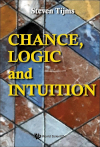- About MAA
- Membership
- MAA Publications
- Periodicals
- Blogs
- MAA Book Series
- MAA Press (an imprint of the AMS)
- MAA Notes
- MAA Reviews
- Mathematical Communication
- Information for Libraries
- Author Resources
- Advertise with MAA
- Meetings
- Competitions
- Programs
- Communities
- MAA Sections
- SIGMAA
- MAA Connect
- Students
- MAA Awards
- Awards Booklets
- Writing Awards
- Teaching Awards
- Service Awards
- Research Awards
- Lecture Awards
- Putnam Competition Individual and Team Winners
- D. E. Shaw Group AMC 8 Awards & Certificates
- Maryam Mirzakhani AMC 10 A Awards & Certificates
- Two Sigma AMC 10 B Awards & Certificates
- Jane Street AMC 12 A Awards & Certificates
- Akamai AMC 12 B Awards & Certificates
- High School Teachers
- News
You are here
Chance, Logic, and Intuition

Publisher:
World Scientific
Publication Date:
2021
Number of Pages:
256
Format:
Hardcover
Price:
68.00
ISBN:
978-9811229183
Category:
General
[Reviewed by , on ]
Adam Loy
07/31/2021
Probability is full of counter-intuitive results. In Chance, Logic, and Intuition, Steven Tijms aims to develop your understanding of probability so that you can identify these counterintuitive scenarios and exercise sound judgment.
Chance, Logic, and Intuition is written for a general audience and is a fusion of history, humor, and problem-solving. It is accessible even to the mathematically adverse, and while Tijms claims that basic arithmetic is the only prerequisite to the book, a healthy sense of curiosity is also needed. While this book is not suitable for a formal course in probability, instructors may find interesting historic “fun facts” or interesting thought experiments that could benefit their teaching.
The book is organized into two parts. Part One outlines the development of probability leading up to the introduction of the term “probability” and Bernoulli’s law of large numbers and seminal work The Art of Conjecturing (Ars Conjectandi). Tijms’s historical account is full of humor, a feature that makes it more accessible to a general audience. For example, he writes a fictional dialogue between Carneades and Chrysippus, two ancient Greek philosophers who never met. In addition, the development constantly returns to gambling (specifically dice games), the motivation behind many of these mathematical developments. While serving a historic purpose, this thread also provides accessible thought experiments where the reader develops probabilistic problem-solving skills without the need for in-depth technical discussion. It should be noted that this discussion focuses on European developments in probability, though, unlike some mathematical histories, Tijms acknowledges this and makes an effort to discuss why this is the case.
Part Two introduces the reader to famous problems/paradoxes, pointing out flaws in our intuition and leading us to sound solutions. Each chapter starts with an example of failures in intuition and/or logic as a foundation to discuss a probabilistic concept. For example, the gambler’s fallacy is introduced through the mania induced by the ball landing on black sixteen times in a row on August 18, 1913, at the Grand Casino in Monte Carlo, and a similar mania that gripped Italy in the early 2000s when at least 182 lottery drawings had omitted the number 53. Similar introductions are given for the fallacy of the transposed conditional, the prosecutor’s fallacy, and the Monty Hall problem. In addition to intriguing motivation, Tijms has crafted thought experiments that allow the reader to pinpoint erroneous intuition and build probabilistic logic. While these thought experiments will not prepare the reader for an exam, they will help them exercise sound judgment in their lives. This part of the book concludes with “Ten Challenging Problems” (and their solutions) for the interested reader, though they would need to have read carefully to grapple with them all.
Adam Loy is an assistant professor of statistics at Carleton College in Northfield, Minnesota. He received his M.S. and Ph.D. in statistics from Iowa State University. Adam teaches statistics at all levels of the undergraduate curriculum at Carleton and regularly teaches probability.
See the publisher's website.
- Log in to post comments




